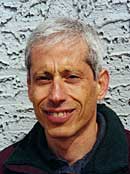
Commentary: Steve Hirsh
April 2000
| |
|
|
|
||
Prior to working with CRRV, Steve was an attorney with Anishinabe Legal Services, representing members of the Leech Lake, White Earth, and Red Lake Bands of Ojibway. He is blissfully married, and has a 23-year-old daughter about to graduate from the University of Minnesota, and a 12-year-old son who will be competing in the Taekwondo Junior Olympics in San Antonio, Texas this summer.
I GREW UP in New York City - the Bronx. So when I moved to Bemidji and was told by my new neighbors about the "bad neighborhoods" I should watch out for, I both chuckled and sighed. Just like back home, "high crime neighborhood" is code for "those people live there." In New York "those people" were blacks or Puerto Ricans. In Bemidji, "those people" are mostly Ojibway.
But more than that, what passes for street crime in Bemidji, as in most of rural Minnesota, just didn't seem that scary. It mostly means stolen cars or the occasional burglary. But over the years I've lived here, I've come to know about other kinds of violence that I never heard about growing up: the violence that goes on in people's homes, with the shades drawn.
It's not inflicted on strangers, only on loved ones. Sometimes it's physical, more often it's verbal, emotional, psychic. It takes the form of hitting, screaming, humiliation, put-downs. It thrives in isolation. No matter the form, it always serves to reduce a spouse or child's sense of themselves, of their importance in the world, of the possibilities available to them. Piece by piece, this violence chisels away at a person's soul.
I work as a regional coordinator for the Center for Reducing Rural Violence. My job is to help rural community leaders - we call them stakeholders - organize themselves to address violence in their communities.
The center's process requires the dismantling of barriers and the building of relationships. Inevitably during that process, stakeholders must address both their own and the community's denial of violence - again, not the headline-grabbing, obvious sorts of tragedies, but the small, unannounced and unwitnessed ones.
While city dwellers may cause and experience similar levels of violence in their homes, some aspects of rural life make it harder for community members to name these issues out loud. There's less anonymity in rural communities. The perpetrators aren't strangers, they are neighbors, co-workers, fellow members of the church congregation. The ethic that what goes on in the home is private and no one else's business, is still strong. And victims are often isolated and either unaware of, or unable to access help.
The Center for Reducing Rural Violence's experience in over 30 rural communities has shown that, given support and access to information, communities can use their own knowledge to create innovative ways to overcome these obstacles.
Recent events have taught us that no community is immune from senseless horror, but the high-profile events in several rural communities shouldn't blind us to the less-dramatic behaviors that, over time, erode a family member's ability to contribute their unique gifts. And that violence, in turn, undermines a community's long-term health, and ultimately, its viability.

